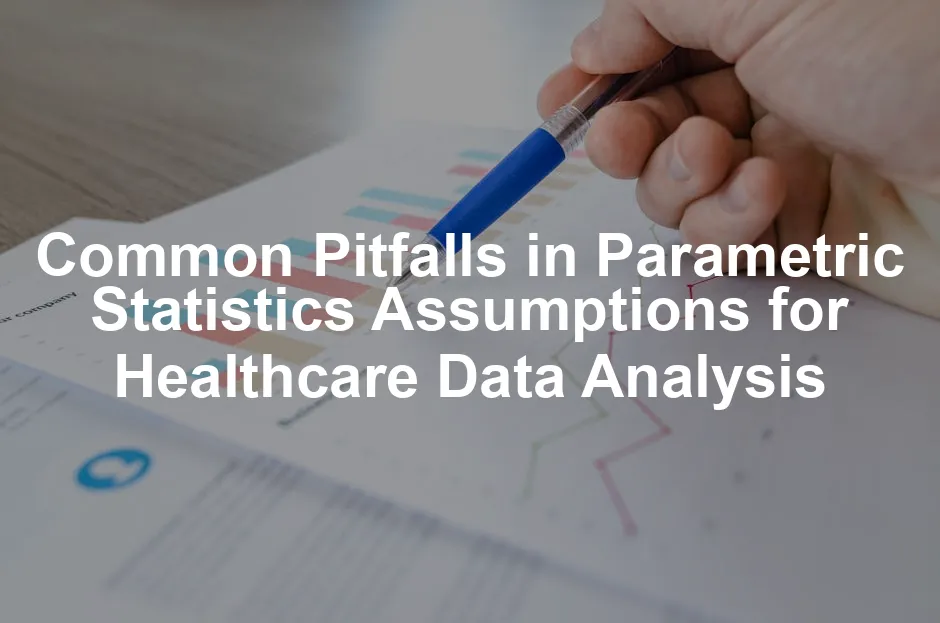Introduction
In healthcare data analysis, parametric statistics are often the go-to tools. Their robustness and efficiency make them popular. However, lurking beneath this facade are common pitfalls that can skew results and mislead researchers. Understanding these missteps is as critical as the data itself. After all, a statistician is someone who can draw a straight line from a crooked thought. This article aims to shine a light on parametric statistics’ shadows, guiding healthcare professionals through the treacherous waters of data analysis with confidence and clarity.
Parametric tests require certain assumptions about the data. These include normality, homogeneity of variance, and sufficient sample size. Ignoring or misinterpreting these assumptions can lead to erroneous conclusions. For instance, many researchers mistakenly believe that their data is normal simply because their sample size is large. Others might overlook outliers, thinking they won’t significantly affect the results. Such oversights can lead to flawed interpretations, ultimately affecting patient care and clinical decisions.
If you want to dive deeper into the world of statistics, look no further than Statistical Analysis with Excel For Dummies. This handy guide breaks down complex concepts into bite-sized nuggets, perfect for those who want to level up their data game without losing their minds!
Additionally, the misinterpretation of p-values is another common pitfall. Researchers often conflate statistical significance with clinical relevance, resulting in misguided conclusions. Furthermore, failing to account for confounding variables can distort findings, leading to false associations. By understanding these pitfalls, researchers can enhance their statistical rigor and produce reliable results that significantly impact healthcare decisions.

Summary of Key Points
This article will explore the most significant pitfalls associated with parametric statistics assumptions in healthcare data analysis. From the misinterpretation of p-values to the dangers of ignoring outliers, each section will highlight a crucial area where researchers often go awry.
- Assumptions of Normality: Many parametric tests rely on the assumption that data follows a normal distribution. Failing to check for normality can lead to incorrect conclusions.
- Homogeneity of Variance: The assumption that different groups have similar variances is often overlooked, leading to potential biases.
- Sample Size and Power: Inadequate sample sizes can result in Type I and II errors, compromising the reliability of findings.
- Misinterpretation of Results: Common misinterpretations, such as confusing statistical significance with clinical relevance, can mislead practitioners.
- Confounding Variables: Neglecting to control for confounding factors can distort the results and lead to false associations.
By understanding these pitfalls, researchers can improve their statistical rigor and produce more reliable results impacting healthcare decisions. Recognizing and addressing these common errors is essential for enhancing the integrity of research findings.

Common Pitfalls in Parametric Statistics
1. Assumptions of Normality
Normal distribution is a bell-shaped curve crucial for many parametric tests. It allows researchers to apply statistical methods that assume data follows this pattern. Why is this important? Because many tests, like t-tests and ANOVA, rely on this assumption to yield accurate results.
The Central Limit Theorem (CLT) states that as sample sizes increase, the distribution of sample means approaches normality. This means that even if individual data points aren’t normally distributed, their means will be, provided the sample size is large enough. It’s like magic—poof! Your skewed data transforms into a friendly bell curve!
However, researchers often overlook this assumption, leading to potential pitfalls. If your data isn’t normal and you still use parametric tests, you might as well be playing darts blindfolded. The results can be wildly inaccurate, influencing healthcare decisions in potentially harmful ways.

To master the art of statistics, consider picking up The Art of Statistics: Learning from Data. This book is an enlightening journey through the world of data, equipping you with the skills to interpret and analyze data like a pro!
Overview of Normal Distribution
To avoid the pitfalls of normality assumptions, testing is essential. Statistical tests like Shapiro-Wilk and Kolmogorov-Smirnov can help assess normality. Think of them as the bouncers at the club of statistics, determining who gets in and who gets sent home.
Visual methods also play a role. Histograms can reveal the shape of your data distribution, while Q-Q plots can help you spot deviations from normality. If your data points fall along the diagonal line in a Q-Q plot, rejoice! Your data is party-ready.
But if they stray, it’s time to reconsider your analysis approach. Ignoring these tests can lead to flawed conclusions and misguided healthcare strategies.

Consequences of Violating Normality Assumptions
Real-world examples abound where neglecting normality led to serious consequences. For instance, in a study on the effectiveness of a new drug, researchers used a t-test without confirming normality. The outcome? Overestimated treatment effects, resulting in the drug being approved without adequate safety evaluations. This not only undermined the study’s credibility but also posed risks to patients.
Another example involves a healthcare survey analyzing patient satisfaction scores. If the scores were skewed and researchers applied ANOVA without checking normality, the results could misrepresent how satisfied patients actually were. Such misinterpretations can have ripple effects, influencing policy decisions and resource allocations in healthcare.
In conclusion, checking for normality is not just a suggestion; it’s a necessity. By ensuring your data meets this assumption, you can enhance the reliability of your findings and make informed decisions that ultimately improve patient outcomes.
For a deeper understanding of the common pitfalls in parametric statistics, including normality assumptions, check out this article on overcoming challenges in parametric statistics assumptions in survey data analysis.

2. Homogeneity of Variance
Homogeneity of variance is a fancy term that means different groups should have similar variances. This assumption is critical in Analysis of Variance (ANOVA) tests. If variances are unequal, the results can be misleading, much like trusting a weather forecast that predicts sunshine during a hurricane.
Levene’s test and Bartlett’s test are two go-to methods for assessing this assumption. They help determine whether the variances are equal across groups, ensuring that your analysis is on solid ground. If Levene’s test returns significant results, it’s a signal to consider alternative approaches, like using non-parametric tests.

If you’re looking to dive deeper into statistical analysis, I highly recommend Discovering Statistics Using IBM SPSS Statistics. This book is an invaluable resource for mastering statistical analysis, providing practical examples that will help you make sense of your data.
Consequences of Violating Homogeneity
Ignoring homogeneity of variance can have dire consequences. Consider a clinical trial comparing the effectiveness of two treatments. If one group has a much larger variance, it can skew the results and lead to incorrect conclusions about treatment efficacy.
One notable case involved a study on heart disease treatments. Researchers applied ANOVA without checking for homogeneity, leading to significant errors in estimating treatment effects. The results favored one treatment over another, but this was based on faulty assumptions. Ultimately, the findings misled healthcare practitioners, impacting patient care decisions.
In short, ensuring homogeneity of variance is essential. By doing so, researchers can uphold the integrity of their analyses and contribute to more accurate healthcare insights.

3. Sample Size and Statistical Power
Sample size is the lifeblood of any research study. An adequate sample size ensures statistical power, reducing the risks of Type I and II errors. A Type I error occurs when you mistakenly reject a true null hypothesis, while a Type II error happens when you fail to reject a false null hypothesis. Both errors can lead to incorrect conclusions, jeopardizing research integrity.
Calculating the appropriate sample size involves considering the expected effect size and the desired power level, usually set at 0.80 or higher. This means you aim for an 80% chance of detecting a true effect. Researchers can use power analysis formulas or software tools to estimate necessary sample sizes, ensuring they have enough data to support reliable conclusions.

For those interested in learning more about data analysis, The Data Warehouse Toolkit: The Definitive Guide to Dimensional Modeling is a fantastic resource. It provides a comprehensive overview of data warehousing, making it easier to understand complex data structures.
Understanding the importance of statistical power is critical for researchers. For more insights, explore our guide on post hoc statistical power.

Consequences of Small Sample Sizes
Small sample sizes can lead to unreliable results. For instance, a study on medication efficacy with only 10 participants may yield significant results purely by chance. One infamous example involved a clinical trial with a small group, which concluded that a new treatment was effective. However, as the study expanded, the results fluctuated dramatically, ultimately showing little to no effect.
Another case involved a public health survey with insufficient respondents. The conclusions drawn from this tiny sample misrepresented the community’s health status, prompting misguided health interventions. Ultimately, these examples illustrate that small sample sizes can misguide healthcare decisions, risking patient safety and resource allocation.
In conclusion, understanding sample size calculations is crucial for researchers. By ensuring adequate sample sizes, they can enhance the reliability of their findings, ultimately benefiting healthcare practices and patient outcomes.

4. Misinterpretation of p-values
P-values are a cornerstone of hypothesis testing. Simply put, they represent the probability of observing the data, or something more extreme, assuming the null hypothesis is true. A p-value helps researchers determine whether the evidence against the null hypothesis is strong enough to reject it. However, many misunderstandings surround this concept.
One common pitfall is p-hacking. This involves manipulating data or testing multiple hypotheses until a desirable p-value is achieved. It’s like trying to fit a square peg into a round hole—eventually, you might force it, but it’s not the right fit. Researchers sometimes cherry-pick results or conduct unnecessary tests, leading to inflated p-values that don’t reflect the true nature of the data.
Another frequent error is misuse of p-value thresholds. Many rigorously adhere to the conventional cutoff of 0.05, mistakenly equating it with a definitive truth. However, a p-value just below 0.05 doesn’t mean the result is practically significant. It’s essential to see p-values as part of a broader context, rather than a sole determinant of truth.
To grasp the nuances between practical significance and statistical significance, refer to our discussion on practical significance versus statistical significance.

Contextualizing p-values
To better understand p-values, researchers should consider effect size and confidence intervals. Effect size quantifies the magnitude of an effect, giving depth to p-values. A statistically significant p-value might indicate an effect, but without understanding the effect size, it’s like knowing a train is fast without knowing its speed.
Confidence intervals (CIs) provide a range of values likely containing the true population parameter. For instance, if you report a p-value of 0.03 alongside a 95% CI of (1.5, 3.5), you’re giving readers a clearer picture of the effect’s potential range. CIs help contextualize p-values, making them not just a number, but a window into the data’s reliability.
In summary, researchers should avoid the trap of viewing p-values in isolation. By integrating them with effect sizes and confidence intervals, they can form a more comprehensive understanding of their research findings. After all, in healthcare data analysis, clarity and context are vital for making informed decisions.

5. Ignoring Confounding Variables
Confounding variables can wreak havoc on study results. These are factors that are related to both the exposure and the outcome, potentially leading to misleading associations. For example, in a study examining the relationship between exercise and weight loss, age can be a confounder. Older individuals might exercise less, affecting their weight, but age itself directly influences weight as well.
Identifying confounders is crucial for accurate analysis. Researchers can employ methods like randomization, which helps ensure that confounding variables are evenly distributed across study groups. Stratification is another technique where researchers analyze data within subgroups, allowing for a clearer view of the relationships without the confounding noise.

Real-World Examples
Several real-world studies have fallen victim to confounding. One classic example is the relationship between coffee consumption and heart disease. Early studies suggested a link, but failing to account for smoking—often correlated with high coffee consumption—led to erroneous conclusions. Once researchers adjusted for smoking, the supposed connection between coffee and heart disease diminished significantly.
Another case involved a study on a new medication’s effectiveness. Researchers overlooked socioeconomic status as a confounder, leading to inflated success rates. By not considering this variable, they misinterpreted the drug’s impact on patient outcomes.
In healthcare research, ignoring confounding variables can lead to misguided interpretations and potentially harmful recommendations. Therefore, identifying and controlling for these variables is essential. By doing so, researchers can ensure their findings are valid, ultimately leading to better healthcare decisions and outcomes.
For healthcare professionals looking for statistical insights, this article on statistics for healthcare professionals on workplace safety 2024 might be particularly relevant.

6. Overreliance on Statistical Significance
Statistical significance is like a flashy advertisement: it grabs attention but doesn’t always deliver the real deal. Defined by p-values, it indicates whether results are likely due to chance. A p-value below 0.05 often gets researchers excited, leading them to proclaim, “Eureka!” But hold your horses! Just because a result is statistically significant doesn’t mean it’s clinically relevant.
Clinical significance, on the other hand, asks the more profound question: “Does this result matter in real life?” For instance, a treatment may statistically lower cholesterol levels, but if the reduction is minuscule—like taking a spoonful of salt out of the ocean—will it truly help patients? This distinction is critical in healthcare. Overvaluing statistical significance can create a false sense of security, where decisions are made based on numbers that don’t translate into meaningful outcomes for patients.

If you’re keen on understanding how data science intersects with business, check out Data Science for Business: What You Need to Know About Data Mining and Data-Analytic Thinking. This book provides a practical guide to leveraging data science in real-world business scenarios, making it a must-read!
Recommendations for Practice
To avoid the traps of overreliance on statistical significance, healthcare researchers should adopt a more holistic approach. First, always report effect sizes alongside p-values. This practice provides context, helping readers understand the practical implications of findings. Think of effect sizes as the “what this means for patients” metric.
Next, utilize confidence intervals to paint a clearer picture. Confidence intervals help gauge the precision of estimates and indicate the range in which the true effect likely lies. For example, if a new drug lowers blood pressure, a confidence interval can show whether this effect is substantial enough to be deemed significant in a clinical setting.
It’s also wise to integrate clinical relevance into research discussions. When presenting findings, explicitly address the potential impact on patient outcomes. Use metrics like the minimal clinically important difference (MCID) to assess whether the observed changes are worth celebrating.
Lastly, researchers should engage with clinicians during study design and interpretation. This collaboration ensures that research questions are grounded in real-world applications, bridging the gap between statistical outcomes and patient care. By focusing on both statistical and clinical significance, researchers can enhance the quality of healthcare data analysis, leading to better-informed decisions that truly benefit patients.
FAQs
What are parametric statistics?
Parametric statistics are methods that assume data follows a specific distribution—usually normal. They include t-tests, ANOVA, and regression analysis. These tests are powerful and can provide precise results when assumptions hold true. However, if the data doesn’t meet these assumptions, results may be misleading.
How can I check for normality in my data?
You can check for normality using statistical tests like Shapiro-Wilk or visually through Q-Q plots and histograms. The Shapiro-Wilk test assesses if your data significantly deviates from a normal distribution. If your histogram resembles a bell curve, you’re on the right track!
What is the impact of a small sample size in parametric tests?
Small sample sizes can create unreliable results, increasing the risk of Type I (false positive) and Type II (false negative) errors. Imagine trying to predict the weather using only two days of data—hardly accurate, right? In research, this can mislead conclusions significantly.
How do I control for confounding variables in my study?
Controlling confounding variables can be achieved through randomization, matching, or statistical adjustments like regression analysis. Think of confounders as sneaky little gremlins that can skew your results. Keep them in check to maintain the integrity of your findings!
Why is it important to differentiate between statistical and clinical significance?
Statistical significance indicates results unlikely to occur by chance, while clinical significance assesses whether the effect is meaningful in practice. For instance, a drug may show a statistically significant effect, but if that effect is negligible in the real world, it might not help patients. Understanding both helps prioritize patient care decisions effectively.
What should I do if my data does not meet parametric assumptions?
If your data does not meet parametric assumptions, consider using non-parametric tests which do not rely on these assumptions. These tests can provide valid results even when the data does not follow a normal distribution.
Please let us know what you think about our content by leaving a comment down below!
Thank you for reading till here 🙂
All images from Pexels




